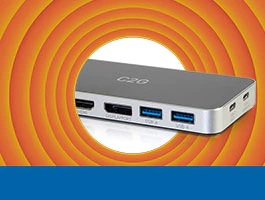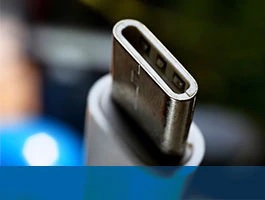USB-C Docking Stations: Alt Mode vs. DisplayLink vs. MHL
Posted on 10/13/2020 7:00:00 PM by C2G Team
What’s really involved in a docking station getting an AV signal out of the device? In the case of USB Type-C, the answer is complicated precisely because of the high performance and versatile nature of this connector. There are three major “systems” that are used to transport video and audio content from a device to a display. Unfortunately, there isn’t an industry-standard method of identifying which products support which standard - or even if they support an AV standard at all! This is likely to be one of the most confusing elements of the wholesale transition to the Type-C interface. It’s imperative that AV system designers and owners be aware of how AV content is treated as a payload.
DISPLAYPORT OVER ALT MODE
DisplayPort is a video interface standard administered by VESA, the Video Electronics Standards Association. DisplayPort bills itself as the “world’s highest performance and most versatile connection technology” and there’s truth in that statement. DisplayPort 2.0, which uses Type-C as a native connection, has a maximum link rate to up to 20 Gbit/s per lane, and is the first standard to support 8K resolution (7680 x 4320) at 60 Hz refresh rate with full-color 4:4:4 resolution, including with 30 bits per pixel (bpp) for HDR-10 support!
At the time of this writing, DP2.0 is still several months in the future. Today’s docking stations will likely support the more modest DisplayPort 1.4a performance, which can deliver an 8.1Gbit/s stream across four lanes simultaneously. Released in April of 2018, DP1.4a includes improvements for features and capabilities such as Display Stream Compression (DSC), Forward Error Correction (FEC) and enhanced MultiStream Transport (MST). MST allows for the transportation of multiple signals over the same cable, supporting multi-display setups.
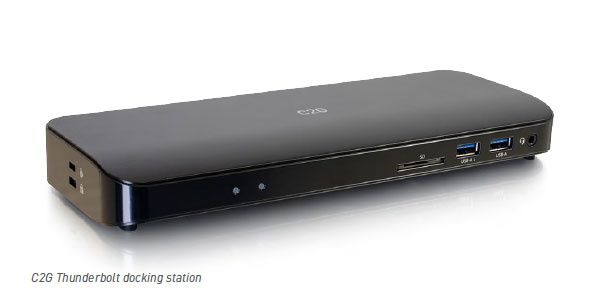
DISPLAY LINK
DisplayLink is the oldest of the three technologies we’ll explore here, having been founded in 2003. DisplayLink was originally designed to work with USB 2.0 connections. It’s a driver-based host codec that’s link aware. Link aware means the algorithm will automatically configure the payload to maximize quality based on the capacity of the connection between the source, dock, and display.
The USB Type-C connector standard mandates that no matter which standards the USB Type-C connector supports, core USB operability will always be supported. As DisplayLink only requires USB signals to operate, DisplayLink will transmit over any USB Type-A or Type-C connector.
DisplayLink technology does not install any hardware on the USB host device, therefore software (specifically a driver) is installed on a host. A hardware rendering engine (HRE) in the docking station converts the USB payload into one conditioned for an HDMI, DisplayPort link or VGA analog connection.
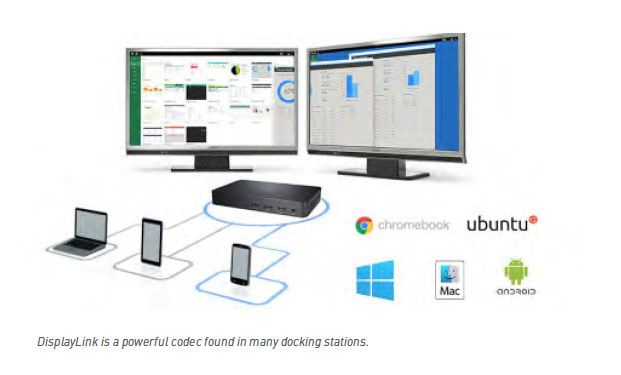
DisplayLink host software can run on Windows, macOS, ChromeOS, Android, and Linux. Most laptops and tablets come with the drivers in place.
Android smartphones may require the installation of an app, DisplayLink Desktop, which is available on the Google Play Store. Be aware that when some phones are connected over Type-C and are charging, the DisplayLink screens may not work. It appears that some Android devices do not go into USB host mode (so they can enumerate USB devices like DisplayLink) when they are being charged. To work around this, you can use a USB C to USB A adapter to connect to the phone, then use a USB A to USB C cable to connect to the DisplayLink dock. This will prevent USB C delivering power to the phone and allow it to enumerate the USB devices connected. Further, Android applications of DisplayLink are limited to one display operating at a maximum of 1080p/
iPhone users may have problems with iOS11, which doesn’t support a DisplayLink driver as of the time of this article. Macbooks may experience issues with macOS Catalina 10.15, but some workarounds are posted on the DisplayLink web site.
MHL
Mobile High Definition Link (MHL) is a wired solution that supports the connection of mobile devices to displays. Under the new superMHL standard, it can support up to 8K video content. MHL is also capable of charging the mobile device (at up to 40 watts) and it can allow for remote control functions from the display to operate the source device. The superMHL connection was first demonstrated at the 2016 CES show.
MHL has primarily been deployed as a discrete input on a monitor or matrix switch. It uses an HDMI connector but it is not an HDMI signal and thus requires specific hardware be included in compatible devices. Using MHL, a passive cable with a USB (typically a micro USB Type-B) connection on one end and an HDMI connection on the other allowed the integration of mobile devices and fixed AV devices with excellent performance parameters.
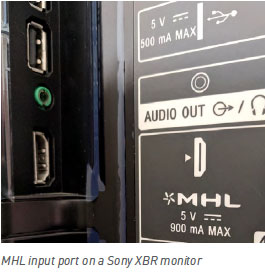
With an eye on the emerging USB Type-C ecosystem, the MHL Consortium developed and published the MHL Alt Mode spec for superMHL™ and MHL 1, 2 and 3 and specifications. MHL established a liaison with the USB 3.0 Promoters Group and USB-IF to ensure interoperability with USB Type-C, USB Power Delivery and USB Billboard specifications. In addition, USB-IF will be working in conjunction with MHL, LLC to establish complementary certification and compliance programs to properly support USB Type-C hosts and devices that incorporate MHL Alt Mode. By some estimates there are over 200 million MHL-compliant devices in the world today.
As with DisplayLink, the biggest compatibility challenge when deploying a docking station for a unified communications and collaboration (UC&C) installation lies with smartphones. Some Android devices (Samsung, for example) deliver a high-performance and intuitive user experience. Other Android phones (Google Pixel, for example) and iPhones do not support the interface at all. Unfortunately, this isn’t made very clear to the owners of those devices who may find it frustrating to connect what appears to be the right port to the right input but fail to get operational results.
SORTING THIS OUT
A dock can terminate an interface and/or peripheral, or it can pass a signal through without change. If the dock supports MHL, DisplayLink, or DP over Alt Mode and terminates the interface, it may grab the video stream and convert the signal to a format such as HDMI or VGA that can be routed, extended and connected in a traditional manner.
What if a docking station supports DP alt-mode, but not DisplayLink? Then the system will display the DP Alt Mode image correctly, but if the monitor doesn’t include a DisplayLink Hardware Rendering Engine (HRE), then it won’t support a DisplayLink image because neither the dock nor the sink has the ability to reconstruct that image.
What if a docking station supports DisplayLink, but not DP Alt Mode? Then it has the software drivers and HRE to display the DisplayLink image correctly, but it won’t recognize the DP Alt Mode stream and devices that use that method to transport AV content won’t be supported.
What if the docking station supports MHL? Since MHL over Type-C is carried via Alt Mode similarly to DisplayPort, then the burden of compatibility will fall to the display or downstream device. Remember that MHL uses an HDMI connector, but it’s not an HDMI signal. Many displays already have this built-in MHL capability.
What about a universal docking station that does it all? Products attempting this level of utility are entering the market, but the serious differences in AV signal topology can make these devices expensive and complex to operate. With all these caveats, the best answer today is to understand the system’s primary use and the products with which it will interface and design accordingly.
Learn all about USB Type-C and docking stations with the other blogs in this series, or get the white paper What’s Up Dock? Putting USB Type-C Docking Stations in Perspective.
There's a Class For That
What’s Up, Dock?
What’s Up, Dock? Putting USB Type-C Docking Stations in Perspective
The challenge for future AV designers will be integrating mobile devices with fixed AV assets. Learn how docking stations solve the problem.
C Into the Future
C Into the Future: The Power of USB Type-CRoughly every 20 years, a technology comes along that is so powerful it changes an entire industry. That technology is USB Type-C!



